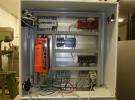I just bought T4 and T7 to use with Kesight VEE.
1. For RS-232 UART of my device, rate of transmission can be used only 56700 or 115200. Can I set T4 or T7 baud rate at 56700 or 115200? The T-series datasheet mention that "the symbol rate that will be used for communication. 9600 is typical. Up to 38400 works, but heavily loads the T7's processor." How can I solve this problem?
2. Could you please provide me the VEE example for RS-232 UART R/W? VEE_VJM doesn't has RS-232 UART example.
Thanks.



.png%3Fitok=PHGBxf6M)


.jpg%3Fitok=B1YcuDFK)
.png%3Fitok=Ybt-OlgU)
Unfortunately, Rs-232 is not electrically compatible with our asynchronous serial feature. Additionally, you will not be able to get past the 38400 baud limitation.
Thanks for quick reply.
Let say that I use the interface chip to solve the electrically compatible problem, such as MAX3232, to shift the voltage levels matched with 3.3V CMOS logic levels of T4, T7.
To use T4 or T7 at 9600 or 38400 baud rate, Could you please provide me an VEE example, sending the byte stream such as [0x11][0x01][0xFF][0xFF] and reading also.
Thanks.
Unfortunately, we do not have any UART examples for VEE. However, we do have an I2C example that could be useful. You can use similar function calls to the I2C example except controlling the async registers rather than I2C registers. We have more information about the async feature setup on the following page:
https://labjack.com/support/datasheets/t-series/digital-io/asynchronous-...
The I2C example can be found in the package on the following page:
https://labjack.com/support/software/examples/ljm/vee
Hi team support, I am coworker with Mr. Kamorn. We try to used the async feature to send ByteArray that we follow with your example link on above. Why the user function on the VEE example does not have LJM_eWriteNameByteArray and LJM_eReadNameByteArray function. Could you please provide us an functions above on VEE.
The ByteArray functions are not included because they are not needed. LJM_eWriteNameArray and LJM_eReadNameArray are virtually indistinguishable from the ByteArray functions in VEE. Please find the basic Asynch example attached for demonstration.